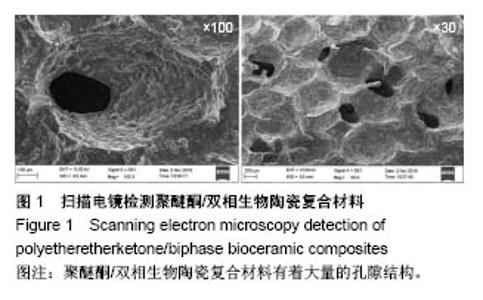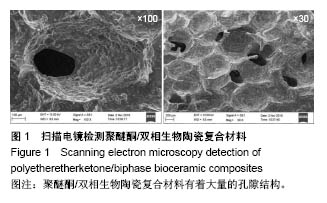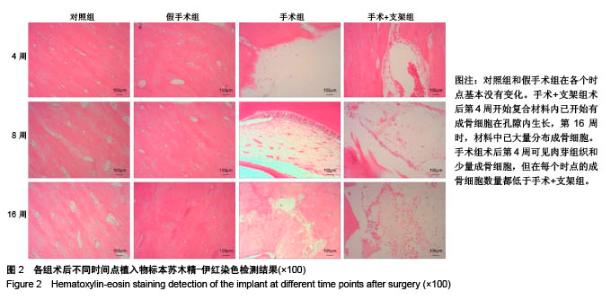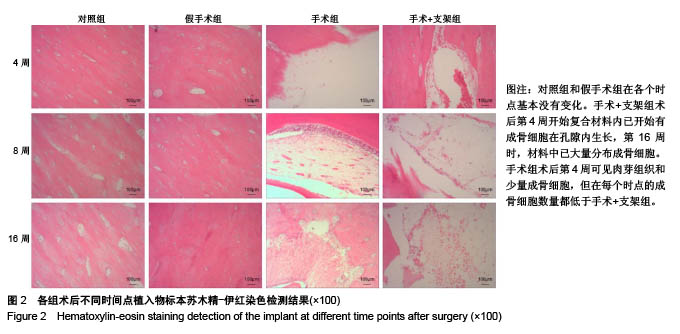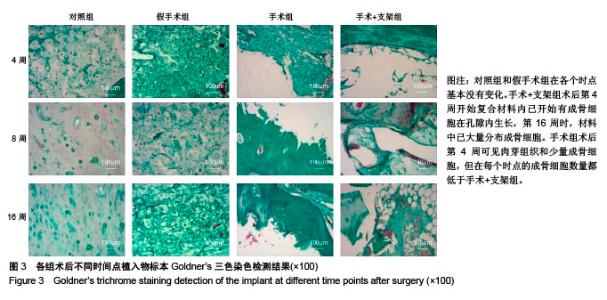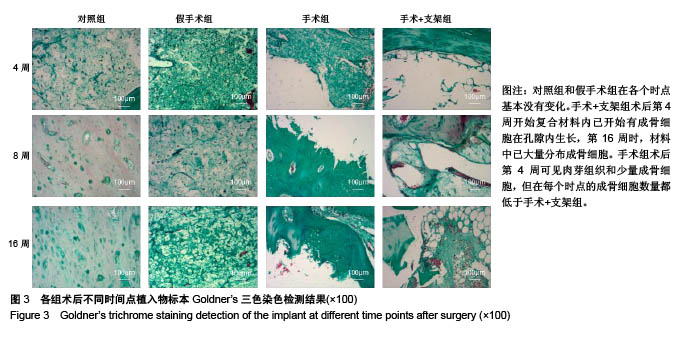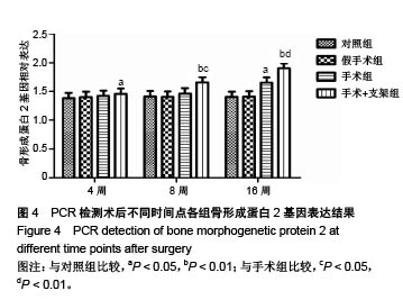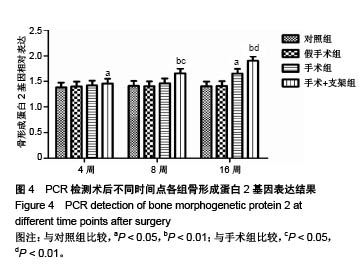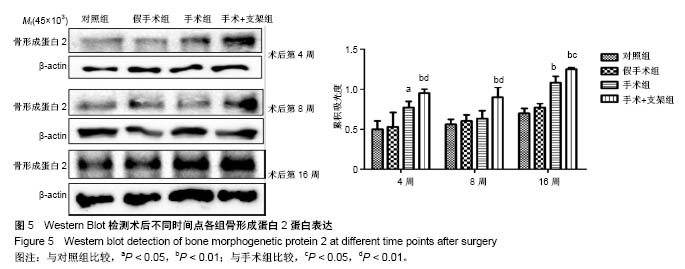| [1] Takahashi Y, Yamamoto M, Tabata Y. Enhanced osteoinduction by controlled release of bone morphogenetic protein-2 from biodegradable sponge composed of gelatin and β -tricalcium phosphate. Biomaterials. 2005;26(23): 4856-65. [2] Zwitser EW, Jiya TU, Licher HG, et al. Design and management of an orthopaedic bone bank in the Netherlands. Cell Tissue Bank. 2012;13(1):63-69. [3] Converse GL, Conrad TL, Roeder RK. Hydroxyapatite whisker reinforced polyetherketoneketone bone ingrowth scaffolds. Acta Boimaterials. 2010;32:856-863. [4] Lee JH, Jang HL, Lee KM, et al. In vitro and in vivo evaluation of the bioactivity of hydroxyapatite-coated polyetheretherketone biocomposites created by cold spray technology. Acta Biomaterials. 2013;9:6177-6187. [5] Simona S, Antonella P, Stefania L, et al. Improved functions of human hepatocytes on NH3 plasma-grafted PEEK-WC-PU membranes. Biomaterials. 2009;30:4348-4356. [6] Dennes TJ, Jeffrey S. A Nanoscale Adhesion Layer to Promote Cell Attachment on PEEK. J Am Chem Soc. 2009; 131(10):3456-3457. [7] Lü K, Zeng D, Zhang Y, et al. BMP-2 Gene Modified Canine bMSCs Promote Ectopic Bone Formation Mediated by a Nonviral PEI Derivative. Ann Biomed Eng. 2011;39(6): 1829-1839. [8] Seol YJ, Kim KH, Park YJ, et al. Osteogenic effects of bone-morphogenetic-protein-2 plasmid gene transfer. Biotechnol Appl Biochem. 2008;49(1):85-96. [9] Yu H, Zeng X, Deng C, et al. Exogenous VEGF introduced by bioceramic composite materials promotes the restoration of bone defect in rabbits. Biomed Pharmacother. 2018;98: 325-332. [10] Rozen N, Lewinson D, Bick T, et al. Role of bone regeneration and turnover modulators in control of fracture. Crit Rev Eukaryot Gene Expr. 2007;17(3):197-213. [11] Wang Z, Li M, Yu B, et al. Nanocalcium-deficient hydroxyapatite-poly (e-caprolactone)-polyethylene glycol-poly (e-caprolactone) composite scaffolds. Int J Nanomedicine. 2012;7:3123-3131[12] Levengood SK, Poellmann MJ, Clark SG, et al. Human endothelial colony forming cells undergo vasculogenesis within biphasic calcium phosphate bone tissue engineering constructs. Acta Biomaterialia. 2011;7(12):4222-4228. [13] Liao F, Chen Y, Li Z, et al. A novel bioactive three-dimensional beta-tricalcium phosphate/chitosan scaffold for periodontal tissue engineering. J Mater Sci Mater Med. 2010;21(2): 489-496. [14] Yu G, Fan Y. Preparation of poly(D, L-lactic acid) scaffolds using alginate particles. J Biomater Sci Polym Ed. 2008; 19(1):87-98. [15] 应艳.两种金属烤瓷冠引起MRI伪影的研究[J].口腔材料器械, 2010,19(2):72-74.[16] 邓纯博,刘冬妍,刘吉泉,等.聚醚醚酮及其复合材料作为骨科植入物的研究进展[J].生物医药工程与临床,2009,13(5):473-476.[17] Kurtz SM, Devine JN. PEEK biomaterials in trauma, orthopedic, and spinal implants. Biomaterials. 2007;28(32): 4845-4869. [18] Pace N, Marinelli M. Tehnical and histologic analysis of a retrieved carbon fiber-reinforced polyetheretherketone composite alumina bearing liner 28 months after implantation. J Arthroplasty. 2008;23(1):151-155. [19] Chen G, Li W, Yu X, et al. Study of the cohesion of TTCP/DCPA phosphate cement through evolution of cohesion time and remaining percentage. J MaterSci. 2009;44(3):828. [20] Sayer M, Stratilatov AD, Reid J, et al. Structure and composition of silicon-stabilized tricalcium phosphate. Biomaterials. 2003;24(3):369-382. [21] Lutfy J, Pietak A, Mendenhall SD, et al. Clinical Application of Mathematical Long Bone Ratios to Calculate Appropriate Donor Limb Lengths in Bilateral Upper Limb Transplantation. Hand(N Y). 2018:1558944717753672. doi: 10. 1177/1558944717753672. [Epub ahead of print][22] Jang JH, Castano O, Kim HW. Electrospun materials as potential platforms for bone tissue engineering. Adv Drug Deliv Rev. 2009;61(12):1065-1083. [23] Bonner M, Ward IM, McGregor W, et al. Hydroxyapatite/ polypropylene composite: a novel bone substitute material. J Mater Sci Lett. 2001;20(22):2049-2051[24] Ishikawa K. Bone substitute fabrication based on dissolution-precipitation reactions. Materials. 2010;3: 1138-1155. [25] Becker A, Epple M, Mttller KM, et al. A comparative study of clinically well-characterized human atherosclerotic plaques with histological, chemical and ultrastructural methods. J Inorg Biochem. 2014;98(12):2032-2038. [26] Dorozhkin SV. Amorphous calcium (ortho)phosphates. Acta Biomaterialia. 2010;6(12):4457. [27] Dean DB, Watson JT, Moed BR,et al.Role of bone morphogenetic proteins and their antagonists in healing of bone fracture.Front Biosci(Landmark Ed). 2009;14: 2878-2888. |
